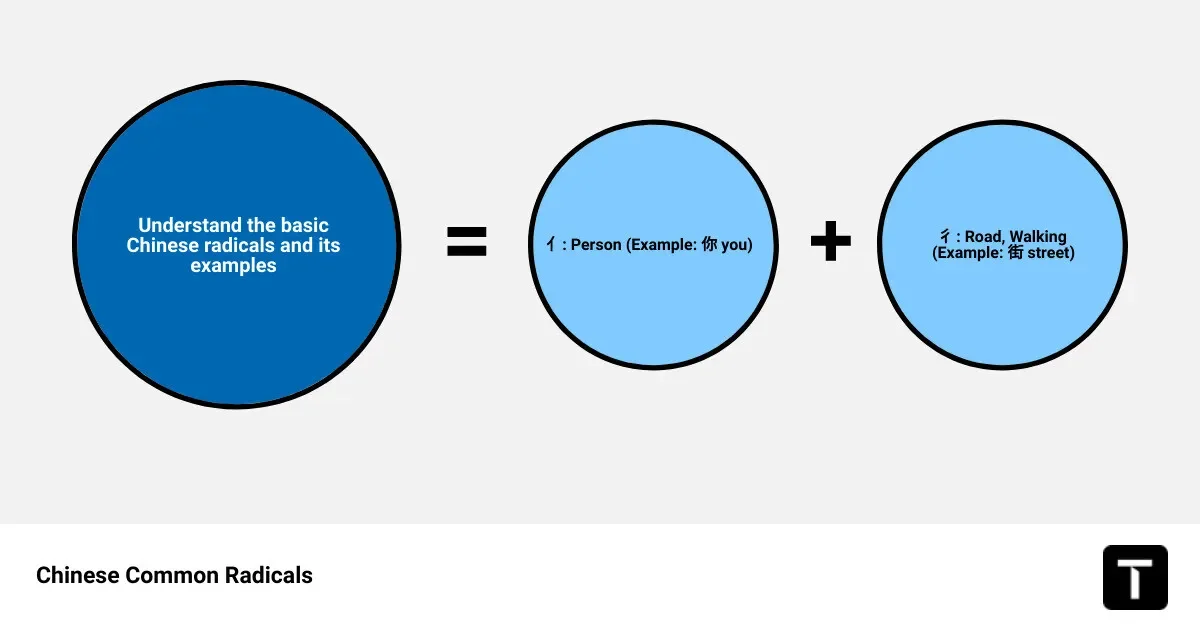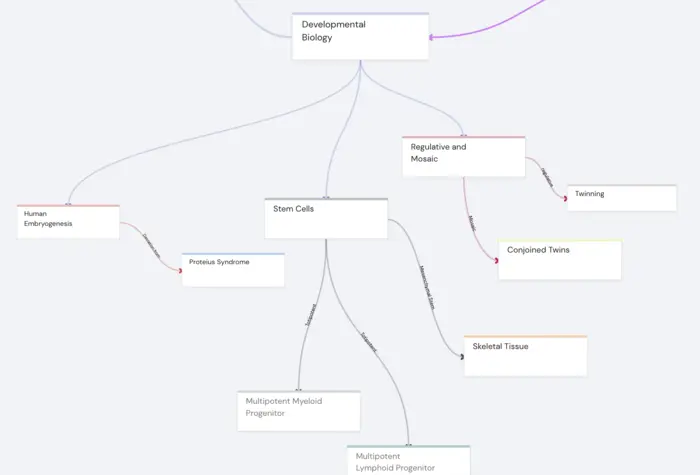Welcome to the captivating world of Chinese characters. When you first encounter Chinese script, it might seem like a complex maze of intricate strokes and shapes, leaving you unsure where to start. But fear not! At traverse, we have a proven strategy to simplify this labyrinth and make your Mandarin learning journey more manageable - and even enjoyable. We focus on Chinese Common Radicals, the fundamental building blocks that make up Chinese characters.
Chinese radicals, known as bù shǒu, are the common "components" that frequently appear in Chinese characters. By understanding these radicals, you can begin to recognize repeating patterns, decipher meanings and memorize characters more efficiently. It's like having a secret codebook to unlock the mysteries of the Chinese language.
Here's a quick look at some of the most common Chinese radicals and their meanings:
| Radical | Meaning | Pinyin | Example | |---------|---------|--------|---------| | 亻 | person | rén | 你 you (nǐ) | | 彳 | road, walking | chì | 街 street (jiē) | | 氵 | water | shuǐ | 河 river (hé) | | 冫 | ice | bīng | 冰 ice (bīng) | | 火 | fire / burning | huǒ | 灯 lamp (dēng) |
Our upcoming sections will dive deep into the world of Chinese radicals, exploring their importance, the most basic ones to start with, the comprehensive list of 214 Kangxi radicals, and even a comparison with Japanese radicals. We will also reveal how we at traverse can support your learning journey with our science-backed tools and strategies. Stay tuned, and let's decode Mandarin together!
Understanding the Importance of Chinese Radicals
Are you ready to dive into the world of Chinese radicals? If you're learning Mandarin, understanding these key components of Chinese characters can be the turning point in your journey. Radicals can seem daunting at first, but as we explore their role in Chinese characters, their aid in memorizing these characters, and their use in categorizing and organizing Chinese characters, you'll see how they can actually simplify your learning process.
Role of Radicals in Chinese Characters
Think of radicals as the roots of a tree, where the tree represents a Chinese character. Just like roots provide vital nutrients to the tree, radicals give important clues about the meaning or pronunciation of a character. Often found on the left-hand side or underneath a character, radicals suggest the semantic field or category of the character. For example, the radical for wood, 木 (mù), is found in characters related to wooden objects such as 桥 (qiáo) for “bridge” or 楼 (lóu) for “building.” Radicals can be literal or abstract, adding depth and richness to the Chinese language.
How Radicals Aid in Memorizing Chinese Characters
Learning Chinese characters can seem like a massive task with over 50,000 characters in the Chinese language. But here's the good news: radicals can significantly aid your memorization process. By providing a hint about the meaning, radicals can help you remember characters more effectively. For instance, if you see the radical 女 (nǚ) meaning woman, in a character, you can infer that the character is related to women. This association can help cement the character in your memory. But remember, the radical’s connection to the overall character isn't always straightforward and can sometimes be related to pronunciation rather than meaning, as in the case with the radical 乙 (yǐ) meaning second, in the word 艺 (yì) meaning skill.
Use of Radicals in Categorizing and Organizing Chinese Characters
Radicals are not just mnemonic aids; they also play a crucial role in categorizing and organizing Chinese characters. The Chinese language is systematized largely based on these radicals. Almost like tags in a blog post, radicals help group related characters and aid in looking up characters in a dictionary. For example, characters with the radical 水 (shuǐ), meaning water, usually have something to do with water, such as river, sea, sweat, or even swim. This system of categorization makes the Chinese language highly systematic and logical, contrary to what many might believe.
Understanding the importance of Chinese radicals is the first step in mastering the Chinese language. As you advance in your studies, you'll see how these fundamental building blocks of Chinese characters can be your greatest allies in your language learning journey. And remember, we at traverse are here to support you every step of the way with our scientifically backed learning tools. So, are you ready to embrace the world of Chinese radicals?
The Basics: Most Common Chinese Radicals
In the vibrant world of the Chinese language, common radicals hold the key to understanding the essence of each character. These radicals, like the roots of a tree, provide a firm foundation for your Mandarin learning journey. Let's examine some of the most common Chinese radicals that you will encounter frequently in your studies.
The Water Radical: 水 ( 氵)

Let's start with the 'Water' radical, 水 (shuǐ). As the name suggests, this radical often indicates that the character is related to water in some way. For instance, words like 河 (hé), meaning 'river', and 洗 (xǐ), meaning 'to wash', both have this radical. Just like the flowing water, the 'Water' radical permeates many words in the Chinese language, providing a clue to the character's meaning.
The Grass Radical: 艹
Next, we have the 'Grass' radical, 艹 (cǎo). This radical is commonly associated with words linked to plants and vegetation, such as 花 (flower) and 草 (grass). It's like the green thumb of Chinese characters, hinting at a connection to the natural world.
The Wood Radical: 木
The 'Wood' radical, 木 (mù), is another common radical. It's a key component in words like 林 (lín), meaning 'forest', and 树 (shù), meaning 'tree'. This radical provides a robust base for characters associated with wood or trees.
The Hand Radical: 手( 扌)
The 'Hand' radical, 手 (shǒu), is often a part of words that involve actions done with the hand. Examples include 推 (tuī), meaning 'push', and 拉 (lā), meaning 'pull'. It's like the hand that shapes the clay of Chinese characters.
The Mouth Radical: 口
The 'Mouth' radical, 口 (kǒu), is commonly found in words related to speech or eating. Examples include 唱 (chàng), meaning 'sing', and 和 (hé), meaning 'and'. This radical speaks volumes about the character's meaning.
The Heart Radical: 心 (忄)
The 'Heart' radical, 心 (xīn), often indicates that the character has something to do with emotions or thoughts. For example, 忘 (wàng) means 'forget', and 情 (qíng) means 'emotion'. It's like the heartbeat of the Chinese character, pumping life into it.
The Female Radical: 女
The 'Female' radical, 女 (nǚ), is used in words related to women or femininity. For instance, 妈 (mā) means 'mother', and 好 (hǎo) means 'good'. This radical adds a feminine touch to the character.
The Fire Radical: 火
Finally, we have the 'Fire' radical, 火 (huǒ). This radical is associated with words related to fire or heat, like 灯 (dēng), meaning 'lamp', and 烧 (shāo), meaning 'burn'. It's like the spark that ignites the meaning of the character.
As you continue to study Chinese, you'll soon recognize these common radicals appearing repeatedly across different characters. This recognition will serve as a powerful tool, making character memorization more manageable and meaningful. Remember, every radical you learn is another step towards proficiency in the fascinating Chinese language.
Advanced Learning: The 214 Kangxi Radicals
After you've mastered the basic Chinese radicals, it's time to delve deeper. There's a treasure trove of language learning to be uncovered in the 214 Kangxi Radicals. This set of radicals, also known as Zihui radicals, offers a more profound insight into the Chinese language, making your learning journey more efficient and enjoyable.
Understanding the Kangxi Dictionary
Let's start with getting familiar with the Kangxi Dictionary. This 18th-century compilation is not just a vital part of Chinese literature, but it also offers a systematic way of categorizing Chinese characters. Named after the Kangxi dictionary, the 214 radicals are primarily sorted by their stroke count, providing an easy-to-follow order for learners.
At Traverse, we make this process even more accessible. Our online table of Chinese Radical allows you to click on a radical, which will then navigate you to a dictionary page displaying all characters with the same radical. This interactive method not only aids in character recognition but also offers a unique insight into the structure and essence of the Mandarin language.
Importance of the 214 Kangxi Radicals
The 214 Kangxi Radicals play a critical role in understanding the semantics of the Chinese language. Each radical acts as a clue to the character's underlying meaning. For instance, the radical for "wood" (木), is often found in characters related to wooden objects, such as "bridge" (桥) or "building" (楼). By recognizing these radicals, you can gain insights into the meaning of more complex characters.
These radicals are more than just building blocks; they are layers of meaning added to the characters. They are essential in understanding the unique Chinese writing structure and offer insights into the meaning of obscure or less frequent characters.
Think of these radicals as keys to decoding a fascinating puzzle. With a deep understanding of these components, you can unlock a whole new perspective of Mandarin, making the learning process more efficient and enjoyable.
At Traverse, we believe in the power of these radicals. Our tools and resources are designed to help you master these radicals, making your learning journey more engaging and efficient.
Unlock the mystery of Mandarin with us. With the right approach, you can turn this complex script into a fascinating puzzle, waiting to be solved.
Comparing Chinese and Japanese Radicals
When it comes to East Asian languages, it's easy to draw parallels between the writing systems of Chinese and Japanese. After all, both languages use logographic characters and share a common history. However, in this section, we'll unveil how Chinese and Japanese radicals differ, particularly in their simplification systems and unique characteristics.
Differences in Simplification Systems
The Chinese language, with its rich history, has seen several changes in its script over time, evolving from traditional characters to simplified ones. This simplification system has made Chinese characters more accessible and easier to write. However, Japanese, despite also utilizing Chinese characters (kanji), followed a different path.
Unlike Chinese, Japanese uses its own simplification system known as shinjitai. Thus, even though traditional kanji and Chinese characters are similar, the simplified versions of both languages are starkly different. This distinction in simplification systems is a key factor to consider when comparing Chinese and Japanese radicals.
Understanding the Unique Aspects of Japanese Radicals
While Chinese and Japanese share a number of radicals, it's essential to acknowledge their unique aspects. Japanese language has incorporated its own set of radicals that are not found in Chinese. These unique radicals, combined with the shinjitai simplification, make the journey of learning Japanese kanji distinct from that of Chinese characters.
The Japanese language also utilizes kana (hiragana and katakana) in addition to kanji, adding another layer of complexity to the language. Each of these scripts plays a specific role in the language, making the study of Japanese radicals a unique and intriguing endeavor.
In sum, while Chinese and Japanese radicals may seem similar at first glance, a deeper look reveals significant differences that make each language unique. At Traverse, we believe in the importance of understanding these nuances, as it not only enriches your language learning experience but also aids in distinguishing between the radicals of these two fascinating languages. In the next section, we'll explore how the Traverse app can assist you in mastering Chinese radicals, helping you decode Mandarin effectively.
How Traverse App Can Aid in Learning Chinese Radicals
As we venture into the digital age, the way we approach language learning has evolved beyond the traditional textbook approach. At Traverse, we believe that with the right tools and methods, mastering Chinese radicals and hence, the Chinese language, can be an enjoyable, effective, and efficient process.
Features of Traverse App for Learning Chinese Radicals
Traverse is not your ordinary language learning app. Our application is designed to help you master Chinese characters in a more efficient, enjoyable, and rewarding way by merging advanced technology with effective learning strategies. The app's primary features include mind mapping, spaced repetition flashcards, and connected note-taking. These features facilitate the encoding, retention, and application of knowledge, creating a seamless and efficient learning experience for the user.
Unlike some other language learning apps that limit users to a certain daily learning session, we at Traverse do not impose such restrictions. We provide a more flexible and comprehensive learning experience that extends beyond the basic radicals, offering a deeper understanding of Chinese characters.
Moreover, our partnership with Mandarin Blueprint, an online Chinese course renowned for its comprehensive and engaging content, offers a full-fledged learning environment catering to all aspects of Mandarin, from reading and writing to understanding the nuances of the language. This collaboration propels you towards Chinese fluency by providing a structured and effective way to learn Mandarin Chinese.
How Cognitive Science Research Supports Learning with Traverse App
Our approach to learning Chinese characters is backed by cognitive science. We ensure that learners don't just memorize information but truly internalize it. The app's spaced repetition system (SRS) uses scientifically-proven techniques to optimize memory retention. It helps learners focus on the words, characters, or concepts they find challenging, ensuring they review them at the right intervals to reinforce memory.
In addition, the mind mapping feature harnesses the power of visual learning, which is crucial since the human brain processes images faster than words. This feature helps learners understand how Mandarin characters interconnect, revealing structures and patterns that make character recall easier and more engaging.
As one user on Reddit noted, "radicals can be utilized by beginners to memorize the character structure in writing, and in the beginning levels, it can also assist in inferring the meaning of the characters." And that's exactly what we aim to achieve with Traverse - providing beginners with a structured and efficient approach to learning Chinese radicals, which will naturally evolve as they progress in their language journey.
Ultimately, we at Traverse are committed to making your journey to learn Chinese characters more than just an app—it's a partnership. With our unique features, science-based approach, strategic partnerships, and integration with popular learning tools, we enhance your learning experience every step of the way. We're unlocking your potential to master Mandarin in an engaging, efficient, and enjoyable way.
To get a hands-on experience of how Traverse can aid in your language learning journey, why not give our app a try?
Conclusion: The Role of Radicals in Mastering Chinese Language
So, we've journeyed through the world of Chinese common radicals, their meanings, and their importance in understanding and mastering Mandarin. It's clear that these radicals are not just mere components of Chinese characters, but rather, they are the building blocks and the keys to unlock the beautiful complexity of the Chinese language.
Remember, radicals are fundamental. They serve as markers for meaning, provide clues to pronunciation, and assist in categorizing and organizing characters. By understanding them, you're not only enriching your vocabulary but also activating your memory and learning efficiency. You're stepping into the world of Mandarin with a refreshed perspective and a powerful tool for comprehension and recall.
Whether we're talking about the common radicals like 水 (water), 艹 (grass), 木 (wood), 手( hand), 口 (mouth), 心 (heart), 女 (female), and 火 (fire), or delving into the advanced learning of the 214 Kangxi Radicals, it's evident that radicals are integral to mastering Chinese. They are the threads that weave together the rich tapestry of the Chinese language, connecting characters, meanings, and pronunciations into a coherent and fascinating language system.
But let's not forget about the beauty of variation in Chinese characters. As we mentioned earlier, variations can arise due to the evolution of characters over time, regional differences, or even individual handwriting styles. This is another aspect of the language that makes it both challenging and rewarding. But don't worry, with the right tools and approach, variations become less daunting and more of an exciting exploration.
This exploration is made much simpler and more enjoyable with the right learning tools. That's where we come in. With Traverse, we've developed an innovative and effective approach that incorporates cognitive science research into language learning. Our app helps you to learn Chinese radicals in a structured, engaging, and efficient way, supporting your journey towards fluency in Mandarin.
And so, as we conclude our deep dive into Chinese common radicals, remember that these seemingly simple strokes are your gateway to understanding and mastering the Chinese language. Embrace them, practice them, and watch as your Mandarin skills take flight.
Ready to take your Mandarin learning to the next level? Try our Traverse app today and see how we can help you master the art of Chinese radicals.

